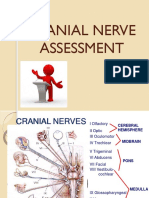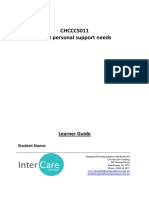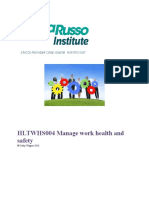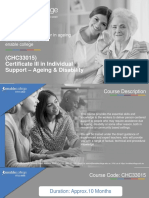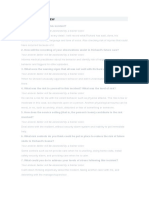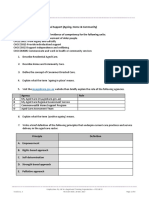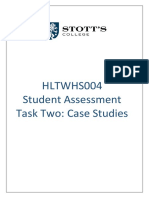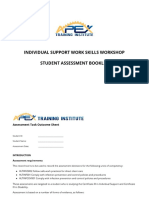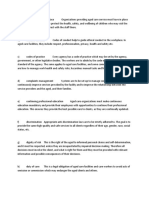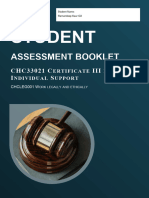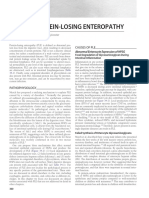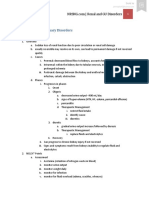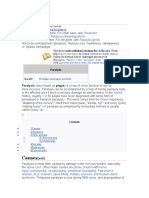Professional Documents
Culture Documents
HLTINF006 Student Assessment Task 1
HLTINF006 Student Assessment Task 1
Uploaded by
Rebeca RaducuOriginal Description:
Original Title
Copyright
Available Formats
Share this document
Did you find this document useful?
Is this content inappropriate?
Report this DocumentCopyright:
Available Formats
HLTINF006 Student Assessment Task 1
HLTINF006 Student Assessment Task 1
Uploaded by
Rebeca RaducuCopyright:
Available Formats
HLTINF006 Apply basic principles and practices ofProvider
CRICOS infection
Code 02934D
RTO Number 121952
prevention and control
Student Assessment
Student Assessment
Task 1: Questioning
HLTINF006
Apply basic principles and practices
of infection prevention and control
CHC30121 Certificate III of Early Childhood
Education and Care
HLTINF006 Apply basic principles and practices of infection prevention
CRICOS Provider Code 02934D
and control Page 1 of 10 RTO Number 121952
Student Assessment - Version 1.0 May 2023
HLTINF006 Apply basic principles and practices of infection
prevention and control
Student Assessment
ASSESSMENT TASK 1 – QUESTIONING
Student Details
☐ I have read and understand unit information and assessment instruction
Student ID 16252 Date 27.06.2023
Student Name Rebeca Raducu
Conditions of The student will have access to the relevant learning resources, listed under the
Assessment learning resource of this document, for this assessment.
Questions will be completed in the student’s own time.
Responses to the questions must be typed.
Student This task requires you to complete a written response knowledge assessment.
Instructions for You are required to answer all 18 questions correctly in Assessment Task 1 –
completion Questioning.
The questions within this assessment relate directly to the integrated knowledge
contained within the unit of competencies and are fundamental to the student’s
knowledge and performance evidence. Use of correct grammar and spelling is
required to demonstrate foundation skills, so please ensure to proofread your
answers prior to submission.
APA referencing must be used where original sources have been used. Do not
copy and paste text from any of the online sources. SCEI has a strict plagiarism
policy and students who are found guilty of plagiarism, will be penalised.
The written assessment standards (8.2) outlined in the PP77 Assessment policy
and procedure apply to this assessment task.
Explanation of the The assessment tasks use a range of instructional words throughout them – such as
common command ‘compare’ and ‘list’. These words will guide the student and yourself as to the level of
words used in the detail that must be provided in their answers. Some questions will also tell you how
Assessment Task many answers the students need to give – for example, ‘Describe three
strategies…’. Use the below glossary to guide you on interpreting the words in the
tasks:
List - You must record short pieces of information in a numbered or bulleted
form with one or two words or sentences on each line.
Outline = provide the main facts about something, more than naming, but
not a detailed description. You must give a brief description of the main facts
or sequence of events about something. The length of the response should
be guided by what you are required to outline. As long as you include the
main facts or points, then that’s enough.
Describe = Provide full details of characteristics and/or features, more
needed than an outline or than a list. This means you should outline the
most noticeable qualities or features of an idea, topic or the focus of the
question
Explain - This means you need to make something clear or show your
understanding by describing it or providing information about it. You will
need to make clear how or why something happened, or something is the
way it is.
HLTINF006 Apply basic principles and practices of infection prevention
CRICOS Provider Code 02934D
and control Page 2 of 10 RTO Number 121952
Student Assessment - Version 1.0 May 2023
HLTINF006 Apply basic principles and practices of infection
prevention and control
Student Assessment
Discuss = Provide a reasonable argument to discuss cause and effect
and/or make links between things clear in your own words
Define – This means you should explain the meaning or interpretation of a
term or concept in your own words, including any qualities which are
essential to understanding.
Analyse = Identify parts, the relationship between them, and their
relationships with the whole. Draw out and relate implications
Demonstrate = Present, show or illustrate through example or action
Assessment You will be provided with a briefing on the assessment and the opportunity to seek
Procedure clarification on the conduct of the assessment.
You may seek clarification at any point in time during the assessment task. If you
feel you need more time to complete the assessment, you must negotiate the time
needed with the assessor prior to the assessment due date.
Following the assessment, your responses will be assessed and marked as
appropriate. Where responses have been assessed in one (1) or more questions
as unsatisfactory, students will be required to resubmit these questions. For more
information, detailed information can be found in PP77 Assessment Policy and
Procedure
Due Date 14 days after the unit completion date as outlined in the PP77 Assessment Policy
and Procedure.
Questions:
1. Complete the question regarding standard precautions for infection prevention and control.
a. What are standard precautions for infection prevention and control and when should they be
used?
Hand hygiene, PPE like gloves, gowns, masks and eye protection, safe handling of contaminated
equipment
b. What is your state/territory legislation relevant to infection control in ECEC Centre? Outline the
standard precautions that must be implemented in your centre.
VIC - infection control guidelines, protocol listed(what should we be wearing) PPE, cleaning,
waste control, safe handling and disposal of sharp, using non-touch techniques and not going to
work when ill.
c. What is the Australian Government body that developed Australian Guidelines for the Prevention
and Control of Infection in Healthcare?
Australian Comision and safety and Quality in healthcare.
d. Describe the purpose of the Australian Guidelines for the Prevention and Control of Infection
The purpose is having effective infection prevention and control (high quality, evidence based)
The guidelines are developed to support prevention and control infections.
2. Explain the requirements of PPE under Regulation 44–47 of the Model WHS Regulations. You can
access the Regulations at safeworkaustralia.gov.au/model-whs-regulations (PC 2.3)
-Minimise risks to health and safety- suitable size and fit-being comfortable while wearing PPE,
maintain / replaced and raped to minimise risk-suitable for the nature of work and any hazards
associate with her, use a worn by workers, workers need to be train or given instructions for use of
HLTINF006 Apply basic principles and practices of infection prevention
CRICOS Provider Code 02934D
and control Page 3 of 10 RTO Number 121952
Student Assessment - Version 1.0 May 2023
HLTINF006 Apply basic principles and practices of infection
prevention and control
Student Assessment
PPE, PCBU are responsible for using PPE (supervisor or manager are responsible if you using PPE)-
as a employee you are responsible to use PPE as directed.
3. Complete the missing fields (hazard type or consequence) in the table below. (PC 1.2)
Hazard Potential harm/consequence
Loud noise Headache, hearing damage, irritating
Electricity Can cause shock, burns, fire or even death.
Stress Aggression, violence, anxiety, difficulty in concentrating, depression
chemicals Can cause respiratory infections or illness, cancer, acid burns or dermatitis.
Manual tasks Back injury, repetitive movements
Working from a height Fall, slip or trip, bruises, fractures, death
Machinery and If hit or caught, can cause fractures, bruises, dislocations, lacerations, serious
equipment injury or death.
Infectious material Waste disposal
4. In one short paragraph, explain the Australian Government: Department of Health and Aged Care
Guidelines for the Infection control in child care settings. (PC 1.4)
https://www1.health.gov.au/internet/main/publishing.nsf/Content/cda-pubs-cdi-1997-cdi2122-
cdi2122a.htm
In order to minimise these risks, it is necessary to apply infection control principles. Infection
risk factors are outlined and recommendations for immunisation, preventative practices, the use
of antibiotics and outbreak management are presented like: Increased risk of infections,
Immunisation of children, Immunisation and screening of staff, Hand washing and the use of
gloves, Cleaning and disinfection, Separation of children in nappies from older children,
Antibiotics in outbreak control, Cohorting of infectious children, Education, surveillance and
reporting
5. Describe how each of the following standard precautions are used to prevent infectious agents
spreading from one person to another. (PC 2.4)
Standard precaution How it is used to stop infection spreading
Respiratory hygiene Cover your mouth and cough in your elbow and when using your hands use a
and cough etiquette tissue a dispose it appropriately and wash your hands or use alcohol. Wearing a
mask
Handling of waste Wearing gloves, follow procedures in disposing appropriately, take the waste out
in the waste area by making sure it is disposed in a correct way, you can
use a trolley for transition or carry an appropriate weight so you will be able
to transfer it without holding it against your body
Handling of soiled/ Using gloves and minimise as much contact with the linen as possible and use
HLTINF006 Apply basic principles and practices of infection prevention
CRICOS Provider Code 02934D
and control Page 4 of 10 RTO Number 121952
Student Assessment - Version 1.0 May 2023
HLTINF006 Apply basic principles and practices of infection
prevention and control
Student Assessment
Standard precaution How it is used to stop infection spreading
contaminated linen/ appropriate PPE. Prevent of getting any mucus membrane the body or blood
work clothes substance. The linen or clothes need to be located into an appropriate laundry
(could be a bucket or a plastic bag). Hand hygiene must be performed and
change the gloves every time they get dirty.
Aprons/gowns Needs to be appropriate and can be reused for purpose.
Not attending work Stop spreading the infection, Minimise the contact with others
when ill
Personal hygiene Personal Care and hygiene
Hand washing, hair should be cleaned and tied back, nails short and clean.
Clean teeth and mouth.
Use of clean clothing or uniform.
Regularly wash it, uniform for work should not be used in other places
Management and laundering of work clothing.
Make sure you don’t travel with the clothes you are supposed to be working
in to minimise infection being spread and separate your clothes from work
clothes
6. Provide at least three infection control methods you can use in ECEC Center for each of the following.
Tasks Infection control methods
General cleanliness in Click here to enter text.Click here to enter text.When using the mop, brushed or
the center clothes, using different colours for distinguish on different rooms/places and
(i.e. housekeeping) prevent the infection spreading, using disinfectant
Cleaning up bodily Encourage regular consistent hand washing and drying procedures
fluid spills for children after all activities. Ensure that adults model hand
washing behaviour for children in an appropriate way. Have
appropriate toileting and nappy changing procedures in place.
Adopt a rigorous cleaning and sanitising program that will
minimise the risk of infection. Wear disposable gloves before
handling dirty nappies or cleaning up blood or any other body
fluid.Click here to enter text.
7. Answer the following questions:
a. In your own words, explain what the pathogens are and outline the four types of pathogens.
A pathogen is usually defined as a microorganism that causes, or can cause a disease.
Bacteria, Viruses, Fungi and Parasites
b. For each of the following pathogens, provide one example of the disease they can cause.
Pathogen Disease
Bacteria Tuberculosis, E.coli
HLTINF006 Apply basic principles and practices of infection prevention
CRICOS Provider Code 02934D
and control Page 5 of 10 RTO Number 121952
Student Assessment - Version 1.0 May 2023
HLTINF006 Apply basic principles and practices of infection
prevention and control
Student Assessment
Pathogen Disease
Viruses covid
Protozoa Giardia, malaria
Fungi Ringworm, thrush
8. Provide at least five examples of when you should wash your hands in the workplace. For each example,
identify the correct hand hygiene product that you should use.
Before and after serving meals, before and after administrate first aid, after toileting, after smoking, after
using the tissue and removing rubbish. Using soap and water. Before preparing meals use a hand
sanitiser or wash hands with water and soap.
9. Using a step-by-step approach, explain how to wash and rub your hands properly.
1.Wet your hands with clean — preferably running — water.2.Apply enough
soap to cover all surfaces of your hands and wrists.3.Lather and rub your
hands together briskly and thoroughly.4. Make sure to scrub all surfaces of
your hands, fingertips, fingernails, and wrists.5.Scrub your hands and wrists
for at least 20 seconds.6.Rinse your hands and wrists under clean —
preferably running — water.7.Dry your hands and wrists with a clean towel, or
let them air-dry.8.Use a towel to turn off the faucet.
10. Fill out the table below about the 5 Moments for Hand Hygiene .
Moment When? Why?
Before touching a child Clean your hands before touching a patient To protect the patient
infected with virus when approaching him/her against colonization and, in
some cases, against
exogenous infection, by
harmful germs carried on
your hands
Before clean/aseptic Clean your hands immediately before To protect the patient
procedure accessing a critical site with infectious risk against infection with
for the patient (e.g. a mucous membrane, harmful germs, including
non-intact skin, an invasive medical device) his/her own germs, entering
his/her body
After body fluid exposure Clean your hands as soon as the task To protect you from
risk involving an exposure risk to body fluids has colonization or infection with
ended (and after glove removal) patient’s harmful germs and
to protect the health-care
environment from germ
spread
After touching a child Clean your hands when leaving the patient’s To protect you from
infected with virus side, after having touched the patient colonization with patient
germs and to protect the
health-care environment
from germ spread
After touching a child Clean your hands after touching any object To protect you from
HLTINF006 Apply basic principles and practices of infection prevention
CRICOS Provider Code 02934D
and control Page 6 of 10 RTO Number 121952
Student Assessment - Version 1.0 May 2023
HLTINF006 Apply basic principles and practices of infection
prevention and control
Student Assessment
infected with virus or furniture when living the patient colonization with patient
surroundings surroundings, without having touched the germs that may be present
patient on surfaces / objects in
patient surroundings and to
protect the health-care
environment against germ
spread
11. Research workplace requirements for hand care for each of the following and write down how you would
follow them.
Skin Apply sunscreen and moisturiser. If having skin issue notify your manager or
supervisor. If having cuts or operations cover it and use a blue bandage.
Fingernails Short and clean, no nail polish
Jewellery/watches Removed them
12. Answer the following questions:
a. Provide an outline of routine surface cleaning procedures in a Early child care centre.
Cleaning a mop by using soapy hot water and leave it outside to dry and prevent infections if
possible out in the sunshine with head up. The bucket should be cleaned after using it with detergent
and hot water and store it upside down appropriately. Chairs and tables should be clean with warm
soapy water and cleaning solution.
b. Provide an outline of enhanced cleaning procedures in a client care centre.
Sanitising by using warm soapy water and disinfection by spray on top of the surfaces and let it dry.
13. Provide a step-by-step overview for disposing needle/syringes into a sharps container.
Put on gloves, if you come across a needle we do not attend to, instead recap it and banded it. We
need to bring the container to us that we are going to put the syringes into it. The container should
be placed on the ground or flat surface beside the syringes and do not ask anyone to hold it or hold
it ourselves. Put the syringes into the middle of the container and pick it up by our hand on the top
part. We do not crack the bell of the syringes and do not flick it. Do not use plastics twisting. Place it
into the container with the sharp down. Securely place the lead on the container and make sure the
lead is sealed. Hold the container by the top and dispose it appropriately.
14. Answer the following questions:
a) Outline the following terms in your own words:
colonisation
infection
disease.
An infection means that pathogens are in or on the body and are causing an illness with symptoms
making a person unwell. Microorganisms can also be in or on the body, but do not make a person sick.
This is called colonization. People who are colonized will have no signs or symptoms. When our own
body's cells, tissues, and organs are being attacked and destroyed by a pathogen our own body's
receptors, cells, tissues, or organs are damaged, destroyed, or inactivated, resulting in an abnormal
state of function, we term that process a disease.
b) Explain the process of colonisation, infection and disease using the following elements:
HLTINF006 Apply basic principles and practices of infection prevention
CRICOS Provider Code 02934D
and control Page 7 of 10 RTO Number 121952
Student Assessment - Version 1.0 May 2023
HLTINF006 Apply basic principles and practices of infection
prevention and control
Student Assessment
pathogen
reservoir
portal of exit
means of transmission
portal of entry
the susceptible host.
You may draw a diagram to help explain your response (attach it to this page) or fill out the table below.
Pathogen Causative Agent - the pathogen (for example bacteria, virus or fungi).
Reservoir a host which allows the pathogen to live, and possibly grow, and multiply. Humans,
animals and the environment can all be reservoirs for microorganisms.
Portal of exit a path for the pathogen to escape from the host. The blood, respiratory tract, skin and
mucous membranes, genitourinary tract, gastrointestinal tract, and transplacental route
from mother to her unborn infant are some examples
Means of since pathogens cannot travel on their own; they require a vehicle to carry them to
transmission other people and places
Portal of entry a path for the pathogen to get into a new host, similar to the portal of exit. Susceptible
Host - a person susceptible to the pathogen
The An essential component in the chain of infection.
susceptible
host
15. Provide at least five risk factors that increase susceptibility of infection.
Age, Heredity, Level of stress, Nutritional status, Current medical therapy, Preexisting
disease process, Medications that weaken the immune system, Cancers that affect the
bone marrow or spread to the bone
16. Answer the following questions:
c) What does the label ‘single use only’ and ‘single patient use’ mean?
single-use medical devices should not be reprocessed
and cannot be used on a separate patient.
d) Describe the process of reprocessing reusable equipment or instruments.
Reprocessing refers to the activities required to ensure that equipment/instruments
are safe for its intended use. Reprocessing is a multistep process that includes
cleaning, inspection and assembly, functional testing, disinfection, packaging and
labelling, sterilization and storage
17. Explain the term ‘degree of pathogen exposure’ and give an example.
The degree of pathogen exposure can be described by the “infectious dose”.
The outcome of exposure to an infectious agent depends, in part, upon
HLTINF006 Apply basic principles and practices of infection prevention
CRICOS Provider Code 02934D
and control Page 8 of 10 RTO Number 121952
Student Assessment - Version 1.0 May 2023
HLTINF006 Apply basic principles and practices of infection
prevention and control
Student Assessment
multiple host factors that determine individual susceptibility to infection and
disease. An example could be coronavirus.
18. What are the steps for applying alcohol-based rub?
Apply an amount of alcohol-based handrub sufficient to cover all surfaces of hands.
Apply handrub to palm of one hand. Rub hands together covering all surfaces of hands
and fingers. Rub until handrub is absorbed. Rub right palm over left with fingers
interlaced and vice versa. Interlink your fingers. Rotational rubbing, backwards and
forwards with clasped fingers in palm. Rotational rubbing of left thumb clasped in right
palm and vice versa. Scrub all surfaces including wrists.
19. Asepsis is the absence of bacteria, viruses, and other microorganisms.
How do you ensure asepsis in the workplace by correctly using PPE?
PPE acts as a barrier between infectious materials and your skin, mouth, nose or eyes.
When used properly, it has the potential to block transmission of contaminants from blood,
body fluids, or respiratory secretions. Using correct PPE protects healthcare workers from
exposure to blood and body fluids/substances. Perform hand washing when needed,
disinfecting articles and surfaces, cleaning the environment, using sterile equipment and
sterile instruments.
Assessment Task Outcome
Result
Submission No.
S = Satisfactory Date Assessed Assessor Name
NS = Not Satisfactory
Click or tap here to Click or tap here to enter
O First submission O S O NS
enter text. text.
Click or tap here to Click or tap here to enter
O Re-submission 1 O S O NS
enter text. text.
Click or tap here to Click or tap here to enter
O Re-submission 2 O S O NS
enter text. text.
The evidence presented is:
HLTINF006 Apply basic principles and practices of infection prevention
CRICOS Provider Code 02934D
and control Page 9 of 10 RTO Number 121952
Student Assessment - Version 1.0 May 2023
HLTINF006 Apply basic principles and practices of infection
prevention and control
Student Assessment
O Valid O Sufficient O Authentic O Current
Reasonable Adjustment
Was reasonable adjustment applied to any aspects of this assessment task? (please tick)
☐ Yes ☐ No
IF YES provide a description of the adjustment applied and why it was applied.
Click or tap here to enter text.
Name of assessor: Carolyn Cullinan Date: 27.06.2023
HLTINF006 Apply basic principles and practices of infection prevention
CRICOS Provider Code 02934D
and control Page 10 of 10 RTO Number 121952
Student Assessment - Version 1.0 May 2023
You might also like
- CHCAGE011 Knowledge Assessment.v1.0Document76 pagesCHCAGE011 Knowledge Assessment.v1.0aryanrana2094250% (2)
- Assessment Task 2 - Case StudyDocument7 pagesAssessment Task 2 - Case StudyPallavi Bhatia38% (8)
- Work Placement Log Book - CHC33015 Certificate III in Individual SupportDocument16 pagesWork Placement Log Book - CHC33015 Certificate III in Individual SupportSalina Bohara40% (5)
- HLTINF006 Assessment Task 1 With AnswerDocument8 pagesHLTINF006 Assessment Task 1 With AnswerRebeca Raducu100% (1)
- CHCDIS005 Develop and Provide Person Centred Service Responses CompleteDocument22 pagesCHCDIS005 Develop and Provide Person Centred Service Responses Completepriyashvi k100% (6)
- Facillitate Empowerment WorkbookDocument83 pagesFacillitate Empowerment WorkbookRumbidzaiNo ratings yet
- HLTWHS002 - HO - HLTWHS002-Follow Safe Work Practices For Direct Client CareDocument34 pagesHLTWHS002 - HO - HLTWHS002-Follow Safe Work Practices For Direct Client CareTalhaFarrukh67% (6)
- Cranial Nerve AssessmentDocument42 pagesCranial Nerve AssessmentValeryn Quiman100% (8)
- HLTINF006 Student Assessment Task 2Document9 pagesHLTINF006 Student Assessment Task 2Rebeca RaducuNo ratings yet
- Jouska Diagram 10Document4 pagesJouska Diagram 10DelNo ratings yet
- WORKBOOK SUBJECT 7 CHCAGE004 Implement Interventions With Older People at Risk CHCAGE003 Co OrdinatDocument181 pagesWORKBOOK SUBJECT 7 CHCAGE004 Implement Interventions With Older People at Risk CHCAGE003 Co Ordinatklm klm100% (1)
- HLTINF001 Student Assessment Task 1 - Questioning...Document10 pagesHLTINF001 Student Assessment Task 1 - Questioning...Muskan SohalNo ratings yet
- Student Assessment Booklet2: Hltaid003 PDocument36 pagesStudent Assessment Booklet2: Hltaid003 PPriyanka SinglaNo ratings yet
- CHCDIV001 - Work With Diverse People: (OLS) Site Under The 'Assessments' TabDocument30 pagesCHCDIV001 - Work With Diverse People: (OLS) Site Under The 'Assessments' TabMax RamirezNo ratings yet
- Assessment Summary / Cover Sheet: Student Assessment CHCCCS015 Provide Individualised SupportDocument16 pagesAssessment Summary / Cover Sheet: Student Assessment CHCCCS015 Provide Individualised SupportGurpreet Singh Wirring67% (3)
- Assignment CHCHCS001 Provide Home and Community Support ServicesDocument2 pagesAssignment CHCHCS001 Provide Home and Community Support Serviceskul199067% (6)
- HLTWHS002 Follow Safe Practices For Direct Client Care SAB v3.0 - THEORYDocument22 pagesHLTWHS002 Follow Safe Practices For Direct Client Care SAB v3.0 - THEORYSujan Adhikari100% (2)
- CHCDIS003 AssessmentDocument28 pagesCHCDIS003 AssessmentVipin Kc100% (1)
- CHCLEG001 Assessment - Tahlia O'Keefe-QuinnDocument3 pagesCHCLEG001 Assessment - Tahlia O'Keefe-QuinnSamantha Abel100% (4)
- Dcs - Hltwhs004 - Task 1 Questions.v2.190203 ADocument9 pagesDcs - Hltwhs004 - Task 1 Questions.v2.190203 AReeta Gurung0% (2)
- Student Assessment Booklet: CHC33015 C III I SDocument26 pagesStudent Assessment Booklet: CHC33015 C III I SSibani Kar0% (2)
- Assign HelpDocument44 pagesAssign HelpRakesh Kumar0% (6)
- CHCLEG001 Student Assessment. V3. 300616Document33 pagesCHCLEG001 Student Assessment. V3. 300616PUNEET KOUR0% (4)
- CHCCCS011 Meet Personal Support Needs Resource InterCare1Document146 pagesCHCCCS011 Meet Personal Support Needs Resource InterCare1komalbajaj100% (1)
- Assessment Summary / Cover SheetDocument15 pagesAssessment Summary / Cover Sheetradhika100% (1)
- Classroom Activity CHCDIS007Document3 pagesClassroom Activity CHCDIS007Sonam Gurung100% (1)
- Student Assessment CHCPAL001 2018 Sarah WorkDocument24 pagesStudent Assessment CHCPAL001 2018 Sarah WorkFrancis Dave Peralta BitongNo ratings yet
- HLTWHS004 Task 2 - Irene OlvisDocument13 pagesHLTWHS004 Task 2 - Irene OlvissachiNo ratings yet
- Skills Assessment: CriteriaDocument19 pagesSkills Assessment: CriteriaAzal YounisNo ratings yet
- BSBWHS302Document17 pagesBSBWHS302Akis Drallos0% (3)
- (CHC33015) Certificate III in Individual Support - Ageing & DisabilityDocument11 pages(CHC33015) Certificate III in Individual Support - Ageing & DisabilityEnable College0% (2)
- Ariane HLTWHS002 Follow Safe Work Practices For Direct Client Care CASE STUDY 2Document1 pageAriane HLTWHS002 Follow Safe Work Practices For Direct Client Care CASE STUDY 2Sandip Paudel0% (1)
- CHCAGE002 Implement Falls Prevention SAB v3.1 THEORYDocument20 pagesCHCAGE002 Implement Falls Prevention SAB v3.1 THEORYAbhishek Dhungel33% (3)
- Information Book CHC33015 Cert III Individual Support Ageing HACC 2019 v1Document15 pagesInformation Book CHC33015 Cert III Individual Support Ageing HACC 2019 v1Andrew100% (1)
- Chcage001 GaganDocument6 pagesChcage001 GaganNimesh Parmar67% (3)
- Task 1 Meet Personal NeedsDocument6 pagesTask 1 Meet Personal Needsdev kumar67% (3)
- Introduction To Six KiDocument7 pagesIntroduction To Six KiSanjeiv Kumar83% (18)
- HLTINF006 Student Assessment Task 3Document14 pagesHLTINF006 Student Assessment Task 3Rebeca Raducu0% (1)
- HLTINF006 Student Assessment Task 1 - 16252 - Rebeca RaducuDocument10 pagesHLTINF006 Student Assessment Task 1 - 16252 - Rebeca RaducuRebeca RaducuNo ratings yet
- CHCCCS015 Provide Individualised Support SAB v3.2 THEORYDocument27 pagesCHCCCS015 Provide Individualised Support SAB v3.2 THEORYShufali Sherchan100% (1)
- CHCDIS002 Follow Established Person-Centred Behaviour Supports SAB V3.4 1Document33 pagesCHCDIS002 Follow Established Person-Centred Behaviour Supports SAB V3.4 1sudip100% (1)
- CHCCOMO3Document35 pagesCHCCOMO3anamika prasadNo ratings yet
- IS01Document8 pagesIS01Anonymous lSPAn1V100% (1)
- CHCAGE013 Student Assessment Booklet V1.1.v1.0Document48 pagesCHCAGE013 Student Assessment Booklet V1.1.v1.0aryanrana209420% (1)
- CHCHCS001 Home & Community SupportDocument23 pagesCHCHCS001 Home & Community SupportSibani KarNo ratings yet
- Dcs - Hltwhs004 - Task 2 Case Studies.v2.190305Document7 pagesDcs - Hltwhs004 - Task 2 Case Studies.v2.190305Crown HuynhNo ratings yet
- HLTHPS007 STDNT Assess BK V3 29.05.19Document139 pagesHLTHPS007 STDNT Assess BK V3 29.05.19Bùi Thắng50% (2)
- Individual Support Work Skills Workshop Student Assessments BookletDocument68 pagesIndividual Support Work Skills Workshop Student Assessments BookletPranav Prajapati0% (2)
- Compliant Aged Care Practice 2Document4 pagesCompliant Aged Care Practice 2Oke AdasenNo ratings yet
- Chcdis003 Case StudyDocument15 pagesChcdis003 Case StudyRajina MaharjanNo ratings yet
- E1144 Module2 Assessment3 SAQrubric 32469 03 v2 3 THyde 1 01 04 2020 2159Document25 pagesE1144 Module2 Assessment3 SAQrubric 32469 03 v2 3 THyde 1 01 04 2020 2159tetyana0% (1)
- Student Assessment Booklet: CHC33015 C III I SDocument23 pagesStudent Assessment Booklet: CHC33015 C III I SSibani Kar0% (1)
- HLTINF006 HLTWHS002 Skills Assessment.v1.1Document64 pagesHLTINF006 HLTWHS002 Skills Assessment.v1.1samridhi.bansal890% (1)
- CHCAGE002Document16 pagesCHCAGE002Niraj NepalNo ratings yet
- CHCPAL001 Student Assessment Booklet - AGE (ID 98478)Document49 pagesCHCPAL001 Student Assessment Booklet - AGE (ID 98478)Francis Dave Peralta Bitong50% (2)
- Int Brochure PDFDocument6 pagesInt Brochure PDFjpanayNo ratings yet
- CHC33015-Work in Health and Community services-LG-F-v1.2Document69 pagesCHC33015-Work in Health and Community services-LG-F-v1.2ஆர்த்தி ஆதிNo ratings yet
- Assessment Task 4: Coordinate Services and Support Activities - Client 1Document15 pagesAssessment Task 4: Coordinate Services and Support Activities - Client 1waniya shaikhNo ratings yet
- CHCLEG001 Student Assessment Booklet V1.0.v1.0Document51 pagesCHCLEG001 Student Assessment Booklet V1.0.v1.0samridhi.bansal89No ratings yet
- HLTINF006_StudentAssessment-Task1_16808Document7 pagesHLTINF006_StudentAssessment-Task1_16808NicomarNo ratings yet
- HLTINF006_StudentAssessment-Task2_16808Document8 pagesHLTINF006_StudentAssessment-Task2_16808NicomarNo ratings yet
- HLTINF001 Student Assessment Task 1 - QuestioningDocument13 pagesHLTINF001 Student Assessment Task 1 - QuestioningUjjwal MaharjanNo ratings yet
- HLTENN035 ASSESSMENT (Case Study) - Sa2793-Diploma of Nursing, Muskanpreet Kaur..Document10 pagesHLTENN035 ASSESSMENT (Case Study) - Sa2793-Diploma of Nursing, Muskanpreet Kaur..Muskan SohalNo ratings yet
- .Nursing Care Plan Poliomyelitis - 1713521478901Document10 pages.Nursing Care Plan Poliomyelitis - 1713521478901Joseph MuzabulaNo ratings yet
- Department of Health ProgramsDocument14 pagesDepartment of Health ProgramsJan Kristel A. QuijanoNo ratings yet
- Manual Compresor VascularDocument24 pagesManual Compresor VascularYessika Grueso OrdoñezNo ratings yet
- Community Health Nursing Exam 5: B. Liver CirrhosisDocument7 pagesCommunity Health Nursing Exam 5: B. Liver CirrhosisHannah BuquironNo ratings yet
- Reticularis With Ulcerations: LivedoDocument21 pagesReticularis With Ulcerations: LivedoGabriela GheorgheNo ratings yet
- Allergic ConjunctivitisDocument16 pagesAllergic ConjunctivitisJose Antonio Fuentes VegaNo ratings yet
- NCP Case PresDocument2 pagesNCP Case PresAnton QueralNo ratings yet
- Genevieve Crane - Approach To Lymph Node-Path Cast Lymph Node Pathology Eve CraneDocument75 pagesGenevieve Crane - Approach To Lymph Node-Path Cast Lymph Node Pathology Eve CraneJose SirittNo ratings yet
- The Development of Nursing As A Profession in IrelandDocument51 pagesThe Development of Nursing As A Profession in IrelandPS LeònNo ratings yet
- Refractive Surgery 3Rd Edition Dimitri T Azar Online Ebook Texxtbook Full Chapter PDFDocument69 pagesRefractive Surgery 3Rd Edition Dimitri T Azar Online Ebook Texxtbook Full Chapter PDFgerald.moore649100% (9)
- Full download Blueprints Psychiatry 6th Edition, (Ebook PDF) file pdf all chapter on 2024Document44 pagesFull download Blueprints Psychiatry 6th Edition, (Ebook PDF) file pdf all chapter on 2024mubinabucilaNo ratings yet
- зан.6 переведеноDocument7 pagesзан.6 переведеноРопннпгпNo ratings yet
- Top 10 Nephro Slides in Board ExamsDocument223 pagesTop 10 Nephro Slides in Board ExamsMirza Shaharyar Baig100% (3)
- Kawasaki Disease CaseDocument64 pagesKawasaki Disease CaseRon Christian Neil RodriguezNo ratings yet
- Protein-Losing Enteropathy: Francisco A. SylvesterDocument10 pagesProtein-Losing Enteropathy: Francisco A. SylvesterNIKEN PUSPITASARINo ratings yet
- (Lib-Ebooks Com) 050420202258 PDFDocument3,395 pages(Lib-Ebooks Com) 050420202258 PDFruchikaNo ratings yet
- Gastrointestinal Food Allergy and Intolerance In.13Document4 pagesGastrointestinal Food Allergy and Intolerance In.13akbar alituNo ratings yet
- Evaluation de Ritis Ratio in Liver Associated DiseaseDocument7 pagesEvaluation de Ritis Ratio in Liver Associated DiseaseTati MulianiNo ratings yet
- Sinusitis SymptomsDocument5 pagesSinusitis SymptomsJulliza Joy PandiNo ratings yet
- Lovenox 40 MLDocument1 pageLovenox 40 MLfaithsamp6No ratings yet
- Antiparasitics:: Ectoparasiticides, Endoparasiticides and Anti-Protozoal AgentsDocument26 pagesAntiparasitics:: Ectoparasiticides, Endoparasiticides and Anti-Protozoal AgentsRISHIKANo ratings yet
- Microcytic AnemiaDocument10 pagesMicrocytic AnemiaGabriel Borboa MarquezNo ratings yet
- SIMCLEX Renal and Genitourinary DisordersDocument7 pagesSIMCLEX Renal and Genitourinary DisorderssandraNo ratings yet
- Bonifacio Case Study GPHDocument6 pagesBonifacio Case Study GPHbabesNo ratings yet
- Mock Exam 2Document18 pagesMock Exam 2Anna StacyNo ratings yet
- ParalysisDocument4 pagesParalysissakuraleeshaoranNo ratings yet
- Rey Complex Figure Test and Recognition Trial (RCFT) ReferencesDocument49 pagesRey Complex Figure Test and Recognition Trial (RCFT) ReferencesMohamad Rizal AnsoriNo ratings yet







